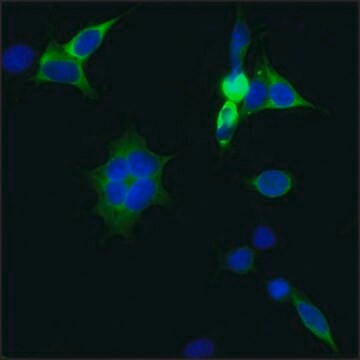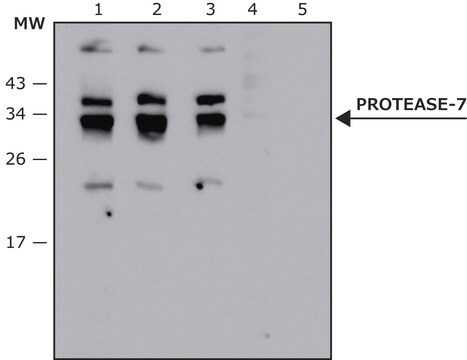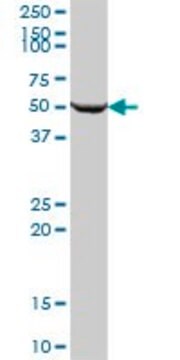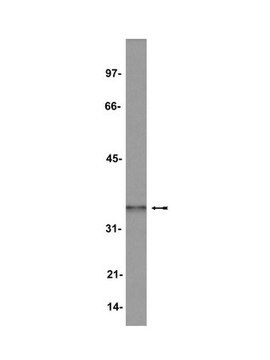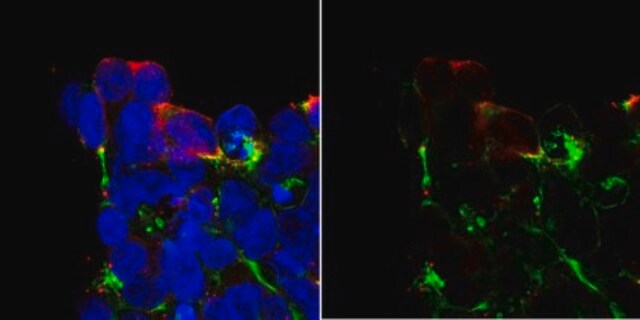SAB4200756
Anti-AsCas12a (Cpf1) antibody, Mouse monoclonal
clone AsCpf-11, purified from hybridoma cell culture
Sinonimo/i:
Anti-AsCpf1 antibody, Mouse monoclonal, Anti-CRISPR-associated endonuclease AsCas12a from Acidaminococcus sp. (strain BV3L6)
About This Item
Prodotti consigliati
Origine biologica
mouse
Livello qualitativo
Forma dell’anticorpo
purified from hybridoma cell culture
Tipo di anticorpo
primary antibodies
Clone
AsCpf-11, monoclonal
Forma fisica
buffered aqueous solution
PM
~135 kDa
Concentrazione
~1.0 mg/mL
tecniche
immunoblotting: 1.25-2.5 μg/mL using purified recombinant AsCpf1 produced in E. coli
immunofluorescence: 1.25-2.5 μg/mL using human HEK-293T cells over-expressing AsCpf1 protein
immunoprecipitation (IP): 2.5-5 μg/test using lysate of human HEK-293T cells over-expressing AsCpf1 protein
Isotipo
IgG2a
N° accesso UniProt
Condizioni di spedizione
dry ice
Temperatura di conservazione
−20°C
modifica post-traduzionali bersaglio
unmodified
Descrizione generale
Cpf1 (CRISPR from Prevotella and Francisella 1) belongs to Class-2 type V CRISPR-Cas endonuclease system.4-5 Cpf1 comprise several differences from Cas9 protein including cleavage with 5′overhangs, a shorter guide RNA and a longer distance between the seed sequence and the cleavage site.
AsCpf1, Cpf1 from Acidaminococcus sp. (strain BV3L6), was examined together with 15 members of Cpf1 nuclease family and shown to mediate efficient genome editing in HEK293FT cells with an improved results compared to SpCas9.5 AsCpf1 crystal structure in a complex with crRNA and partially duplexed target DNA, shows that AsCpf1 acts as a monomer thus identifying a unique mechanism employed by AsCpf1 for target recognition.
Immunogeno
Applicazioni
- immunoblotting (~135 kDa),
- immunofluorescence
- immunoprecipitation
Monoclonal anti-AsCpf1 antibody can provide a useful tool for genome editing research such as detecting and monitoring AsCpf1 positively transfected cells.
Stato fisico
Stoccaggio e stabilità
Altre note
In order to obtain best results in different techniques and preparations we recommend determining optimal working concentration by titration test.
Non trovi il prodotto giusto?
Prova il nostro Motore di ricerca dei prodotti.
Codice della classe di stoccaggio
10 - Combustible liquids
Punto d’infiammabilità (°F)
Not applicable
Punto d’infiammabilità (°C)
Not applicable
Certificati d'analisi (COA)
Cerca il Certificati d'analisi (COA) digitando il numero di lotto/batch corrispondente. I numeri di lotto o di batch sono stampati sull'etichetta dei prodotti dopo la parola ‘Lotto’ o ‘Batch’.
Possiedi già questo prodotto?
I documenti relativi ai prodotti acquistati recentemente sono disponibili nell’Archivio dei documenti.
Il team dei nostri ricercatori vanta grande esperienza in tutte le aree della ricerca quali Life Science, scienza dei materiali, sintesi chimica, cromatografia, discipline analitiche, ecc..
Contatta l'Assistenza Tecnica.


